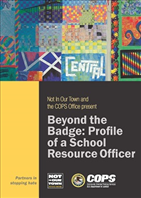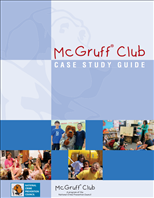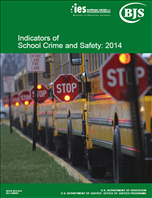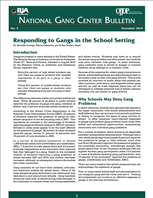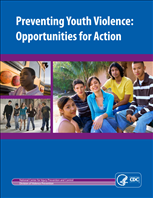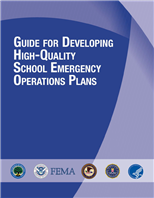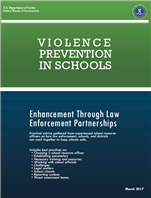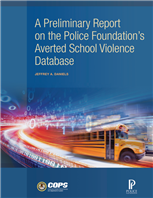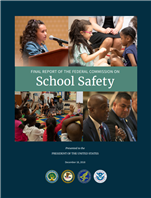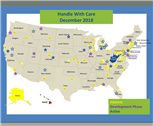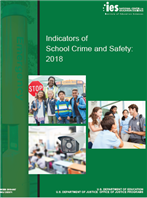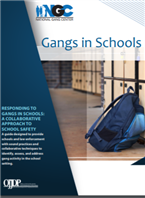McGruff Club
McGruff Club is a crime prevention and safety education program for children who are between the ages of six and ten. Through McGruff Club, children become engaged in their communities and learn about safety while having fun with their friends and adults who care for them. McGruff Club is for children between the ages of 6 and 10. Children meet once a week for 30 to 45 minutes. They spend meetings identifying safety concerns, learning how to stay safe, engaging in service projects, and reflecting upon and celebrating those projects. All children in McGruff Club explore the topics of safe and unsafe neighborhoods, conflict management, bullying, and dangerous situations in the neighborhood. McGruff Clubs address additional issues based on the concerns of the children, which may include diversity, Internet safety, guns and other weapons, and home safety.
Beyond the Badge: Profile of a School Resource Officer DVD
In the midst of turmoil and division between law enforcement and the community of Ferguson, Missouri, St. Louis County School Resource Officer Ronald Cockrell works to bridge the gap between students and police officers. Beyond the Badge: Profile of a School Resource Officer follows Officer Cockrell during a school day at Central Middle School in Riverview Gardens, six months after the police shooting and protests that left North St. Louis County reeling. The story focuses on Cockrell's efforts to build relationships, listen to students address fear of the police in a school town hall, mentor young people on how to deal with conflicts, and work with his colleagues to respond and support a student whose father is murdered. This short film is designed to prompt conversations in law enforcement agencies, schools, and communities about the role SROs can play in improving relationships between students and law enforcement and mentoring and supporting young people as they navigate conflicts and interactions with the justice system. This film is part of the Working Together for Safe, Inclusive Communities Initiative, a collaboration between Not In Our Town and the U.S. Department of Justice's Office of Community Oriented Policing Services. This free resource is available for law enforcement agencies to use in their communities.
McGruff Club Curriculum
McGruff Club Curriculum will reach a new generation of children, teaching them to resolve conflicts nonviolently, say no to drugs, surf safely online, and take a stand against bullying. It contains scripted lessons guide instructors through classroom discussions and activities for children in grades 1 through 4. It also has activities, incorporating proven teaching strategies, develop children's critical thinking and communication skills. User-friendly program guides make it easy for educators, counselors, school administrators, law enforcement officers, and youth service providers to implement McGruff Club.
School and Campus Crime
Victimizations occurring at school are an important subset of crime, given the amount of time that young people spend there. While schools (K-12) and post- secondary campuses are relatively safe places, victimization does occur, and the risks vary by context. Adolescents, for example, experience more violent victimizations at school but more serious violent victimizations outside of school (see Child, Youth, and Teen Victimization). And national studies suggest that stalking victimization rates are higher among college-age women than the general population. Concerns over reporting and preventing violence against women, in particular rape and sexual assault, have led to greater focus by campus administrators and policy makers. Regardless of age, students who are victimized at school often have their physical and emotional well-being negatively affected, as well as their ability to learn.
Indicators of School Crime and Safety: 2014
This report presents the most recent data available on school crime and student safety. The indicators in this report are based on information drawn from a variety of data sources, including national surveys of students, teachers, principals, and postsecondary institutions. Sources include results from the School-Associated Violent Deaths Study, sponsored by the U.S. Department of Education, the Department of Justice, and the Centers for Disease Control and Prevention (CDC); the National Crime Victimization Survey and School Crime Supplement to that survey, sponsored by BJS and NCES, respectively; the Youth Risk Behavior Survey, sponsored by the CDC; the Schools and Staffing Survey and School Survey on Crime and Safety, both sponsored by NCES; the Supplementary Homicide Reports, sponsored by the Federal Bureau of Investigation; EDFacts, sponsored by NCES; and the Campus Safety and Security Survey, sponsored by the U.S. Department of Education.
Responding to Gangs in the School Setting
A 2010 National Gang Center Bulletin addressing the problem and assessment of gangs in schools and potential solutions.
Preventing Youth Violence: Opportunities for Action
To help communities take advantage of the available knowledge, CDC has developed, Preventing Youth Violence: Opportunities for Action. This resource summarizes what we currently know about youth violence—the health consequences, trends, disparities, causes, costs, and prevention strategies. This resource outlines important strategies for youth violence prevention that are based on strong evidence and experience. It includes examples of specific programs and activities that have been found to be effective. These evidence-based youth violence prevention strategies focus on reducing the factors that put young people at risk for violence and bolstering the factors that strengthen their positive development and buffer against violence.
Real Talk - A Resource Guide for Educating Teens on Healthy Relationships
Designed for adults who work directly with youth, either in a school or community setting, this resource is intended to assist youth workers in facilitating dialogue about teen dating violence and preparing them to teach healthy relationship skills to youth.
Real Talk - Conversation Cards for Educating Teens on Healthy Relationships
Designed for adults who work directly with youth, either in a school or community setting, this resource is intended to assist youth workers in facilitating dialogue about teen dating violence and preparing them to teach healthy relationship skills to youth.
Guide for Developing High-Quality School Emergency Operations Plans
Lessons learned from school emergencies highlight the importance of preparing school officials and first responders to implement emergency operations plans. By having plans in place to keep students and staff safe, schools play a key role in taking preventative and protective measures to stop an emergency from occurring or reduce the impact of an incident. Although schools are not traditional response organizations, when a school-based emergency occurs, school personnel respond immediately. They provide first aid, notify response partners, and provide instructions before first responders arrive. They also work with their community partners, i.e., governmental organizations that have a responsibility in the school emergency operations plan to provide a cohesive, coordinated response. Families and communities expect schools to keep their children and youths safe from threats (human-caused emergencies such as crime and violence) and hazards (natural disasters, disease outbreaks, and accidents). In collaboration with their local government and community partners, schools can take steps to plan for these potential emergencies through the creation of a school Emergency Operations Plan (school EOP). This document is intended to serve as a guide for the planning teams responsible for developing and revising school EOPs . It is recommended that districts and individual schools compare existing plans and processes against the content and processes outlined in this guide. To gain the most from it, users should read through the entire document prior to initiating their planning efforts...
Violence Prevention in Schools: Enhancement Through Law Enforcement Partnerships
This document provides practical advice gathered from experienced school resource officers on how law enforcement, schools, and districts can work together to keep schools safe.
A Preliminary Report on the Police Foundation's Averted School Violence Database
The Police Foundation, in collaboration with the COPS Office, implemented the Averted School Violence (ASV) database to provide a platform for sharing information about averted incidents of violence in institutions of elementary, secondary, and higher education. The ASV project defines an incident of averted school violence as a violent attack planned with or without the use of a firearm that was prevented before any injury or loss of life occurred. This preliminary report analyzes 51 averted incidents of school violence selected from the ASV database to begin to improve our understanding of averted school attacks. The report begins with a case study of one averted attack and then details findings on the 51 averted incidents in the study. It concludes with recommendations for law enforcement and school administration to improve school safety. A companion report (Langman and Straub 2018) compares these 51 averted attacks with 51 completed attacks and presents findings on the similarities and differences.
Final Report of the Federal Commission on School Safety
Following the school shooting in Parkland, FL, President Trump established the Federal Commission on School Safety. He tasked the Commission with producing a report of policy recommendations in an effort to help prevent future tragedies. The Commission's work included field visits, listening sessions, and meetings with anyone and everyone who is focused on identifying and elevating solutions. After learning from students, parents, teachers, school safety personnel, law enforcement officers, mental health professionals, and others who play a role in keeping students safe, the Commission developed recommendations for leaders at the local, state, and federal levels. The key observations and recommendations are included in this report. The Commission's goal has been to identify local, state, and federal policy for lawmakers and local officials to consider. The report’s recommendations can assist states and local communities in preventing school violence and improving recovery efforts following an incident.
COAP Webinar: Handle With Care
This webinar showcases innovative best practices to mitigate the negative effects experienced by children exposed to trauma—including an arrest or incident related to opioid use—and highlights Handle With Care. This promising initiative partners schools and child-care agencies, law enforcement, and treatment providers to promote safe and supportive homes, schools, and communities with the goals of protecting children and helping traumatized children heal and thrive. When an officer encounters a child during a call, that child's name and three words—HANDLE WITH CARE—are forwarded before the school bell rings the next day. Schools respond with interventions to help mitigate the trauma, and mental health providers are being co-located at schools to provide services.
Indicators of School Crime and Safety: 2018
This report is the 21st in a series of annual publications produced jointly by the National Center for Education Statistics (NCES), Institute of Education Sciences (IES), in the U.S. Department of Education, and the Bureau of Justice Statistics (BJS) in the U.S. Department of Justice. This report presents the most recent data available on school crime and student safety.
Responding to Gangs in Schools: A Collaborative Approach to School Safety
A guide designed to provide schools and law enforcement with sound practices and collaborative techniques to identify, assess, and address gang activity in the school setting.

